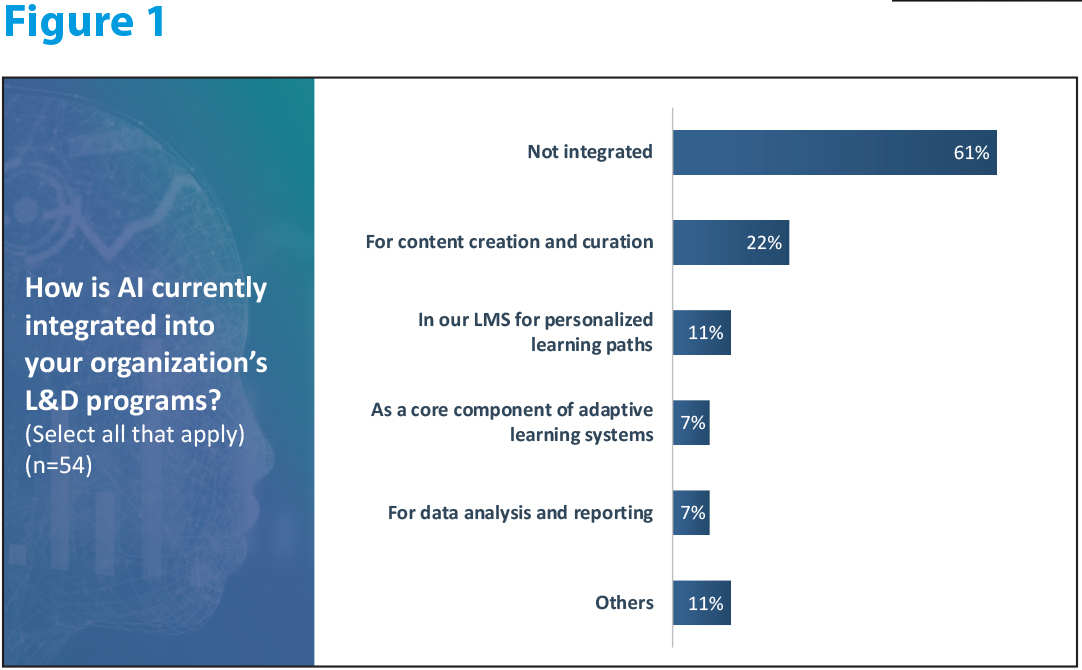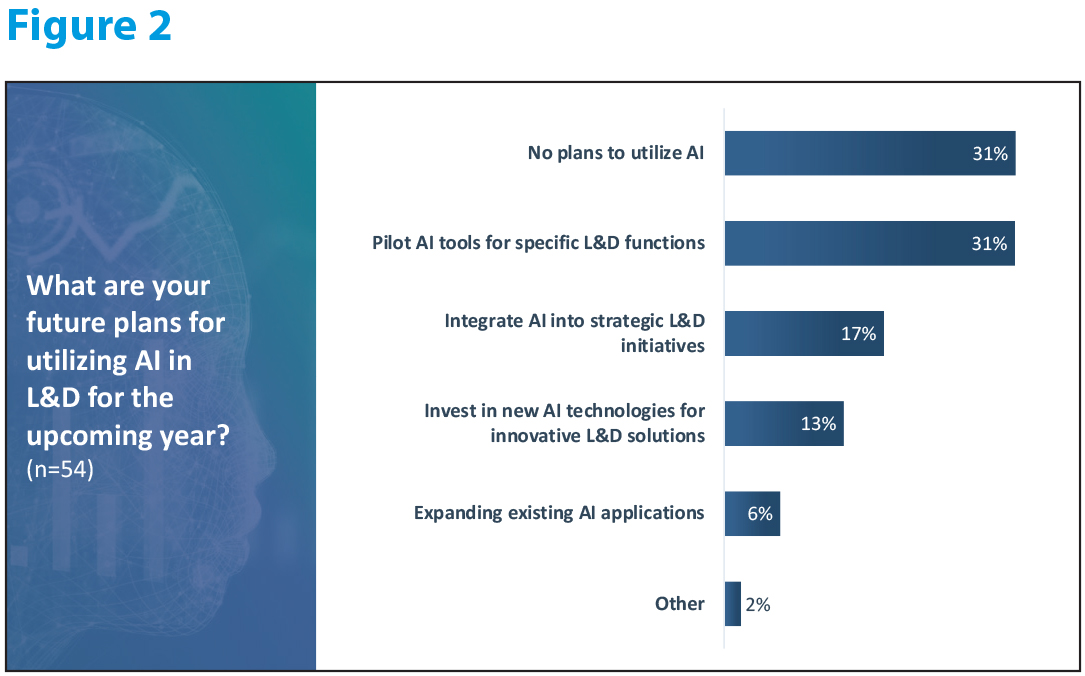
Artificial intelligence (AI) holds immense potential to revolutionize learning and development (L&D) in the life sciences industry. Despite the excitement around this technology, data from TGaS Advisors’ annual state of L&D landscape survey shows that many organizations are hesitant to fully embrace AI in their training programs.
Understanding the barriers to AI adoption and finding ways to overcome them is crucial for unlocking AI’s full potential in enhancing L&D.
The Current Landscape: Low Integration of AI
Our annual state survey reveals that 61% of organizations have not yet integrated AI into their L&D programs (Figure 1). This highlights several key challenges:
- Lack of Understanding and Expertise: The complexity of AI makes it difficult for many organizations to grasp its practical applications and benefits, leading to hesitation in adoption. There is often a knowledge gap within L&D teams about how to effectively implement and use AI technologies.
- High Costs and Resource Constraints: Implementing AI solutions requires significant investment. Organizations are often wary of the upfront costs and the resources needed to maintain and scale these technologies. The budget constraints can be particularly challenging for smaller firms orthose already allocating substantial resources to other critical areas.
- Regulatory and Compliance Concerns: The life sciences sector operates under strict regulatory frameworks. Integrating AI into L&D can raise concerns about compliance and the potential for complicating regulatory adherence. Ensuring that AI applications meet these stringent standards is crucial but can be a complex and resource-intensive process.
- Integration with Existing Systems: Many organizations have entrenched L&D systems that are not easily compatible with new AI technologies. The challenge of integrating AI with legacy systems can be a significant barrier. This issue is compounded by the need for seamless interoperability across various platforms and tools already in use.

Effectiveness of AI in L&D
Data from our annual state of L&D landscape also indicates that57% of respondents report only minor improvements in engagement or proficiency when using AI in L&D. While AI holds promise, its current applications may not yet be fully optimized.
Nevertheless, some organizations have seen moderate to transformational benefits, such as enhanced knowledge retention, personalized learning experiences and improved business performance.
AI-driven personalized learning paths can adapt to the individual needs of learners, providing customized content that enhances engagement and retention. This approach 2 significantly improves the learning experience by catering to the specific strengths and weaknesses of each learner.
Additionally, AI can facilitate adaptive learning systems that adjust the difficulty and pacing of training modules based on real-time performance data.
Future Plans for AI in L&D
Looking ahead, 31% of organizations plan to pilot AI tools for specific L&D functions, while another 31% have no plans to utilize AI. This mixed outlook highlights the cautious yet growing interest in exploring AI’s potential. For those ready to take the plunge, focusing on pilot programs and continuous improvement can be key strategies.
Organizations planning to pilot AI tools are looking at applications such as predictive analytics for identifying learning gaps, automating routine administrative tasks and enhancing the interactivity of e-learning platforms. By starting with focused pilot projects, organizations can gather valuable insights and gradually expand their AI initiatives based on demonstrated success.

Strategies for AI Adoption in Life Sciences L&D
To bridge the AI gap in L&D, life sciences organizations can adopt several practical strategies (Figure 2):
- Pilot Programs: Start with small-scale pilot programs to test AI applications in specific L&D functions. This allows organizations to evaluate the effectiveness of AI and adjust before broader implementation.
For example, focusing on AI for content creation and curation, as 22% of survey respondents have done, can provide immediate benefits. Pilot programs also allow for the assessment of AI’s impact on learner engagement and knowledge retention.
- Continuous Improvement Initiatives: Implement a continuous improvement approach to AI adoption. Regularly review and optimize AI solutions based on user feedback and evolving needs. Continuous improvement ensures that AI tools remain effective and relevant, adapting to changing organizational needs and technological advancements.
- Invest in Training and Education: Overcoming the expertise barrier involves investing in training programs that build internal knowledge about AI. Educating L&D professionals on AI capabilities and how to leverage these technologies can enhance training programs. This investment in education ensures that teams are well-equipped to implement and manage AI solutions, driving successful adoption and utilization.
- Collaborate with AI Suppliers: Partner with AI suppliers who specialize in life sciences to ensure solutions are tailored to the industry’s unique requirements. Collaboration with experienced partners provides access to specialized knowledge and resources, facilitating the successful deployment of AI technologies.
Enhancing Learning Experiences With AI
AI can transform the development of training materials by automating content creation and ensuring that learning modules are up to date with the latest scientific research and regulatory changes. AI-powered analytics provide insights into learner performance, identifying areas where additional training or support may be needed. By analyzing individual learning patterns and preferences, AI can recommend tailored training paths that optimize engagement and knowledge retention.
This level of personalization significantly improves the effectiveness of L&D programs, ensuring that learners receive the right training at the right time. AI-driven adaptive learning systems can adjust the difficulty and pacing of training modules based on real-time performance data, providing a dynamic and responsive learning experience.
By leveraging these capabilities, organizations can create more engaging and effective training programs that meet the diverse needs of their learners.
Embracing the Future of AI in L&D
Integrating AI into L&D programs in the life sciences sector presents both challenges and opportunities. By understanding the barriers to adoption and leveraging approaches such as pilot programs, continuous improvement initiatives and comprehensive support, and considering solutions like those offered by industry partners, organizations can unlock the full potential of AI to revolutionize their training programs.
Embracing AI will enhance learning outcomes, drive innovation and improve efficiency across the organization, positioning life sciences companies for continued success in an increasingly competitive landscape. The transformative power of AI promises to reshape the future of L&D, enabling organizations to stay ahead of the curve and achieve unprecedented levels of performance and growth.